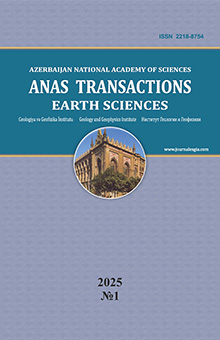Structural conditions for the localization of gold mineralization within the Tutkhun ore field (the central part of the Lesser Caucasus)
Baba-zadeh V.M., Abdullayeva Sh.F., Novruzova S.R.
Baku State University, Azerbaijan 33, acad. Zahid Khalilov str., Baku, AZ 1148: vasifbabazadeh1938@bsu.edu.az; shakhla.a@gmail.com; samiranovruzova001@gmail.com
DOI: 10.33677/ggianas20240100112
Summary
The gold-bearing areas of the ore field, the similarities and differences of the structural conditions of their formation, the elemental and mineral composition of the ores, various metasomatictes-propylites, beresites and, especially, secondary quartzites were studied.
Gold ore mineralization can be considered in terms of some regional features of the geological development of the Lesser Caucasus. The Upper Eocene intrusive and subvolcanic rocks represent a single complex that forms the Gazikhanli-Zargulu massif in the region, approaching the subvolcanic facies of magmatic rocks. The field of development of gold ore formations mainly covers outcrops of granitoid rocks of the massif and its exocontact aureoles, into which abundant dikes, the latest members of the Upper Eocene complex of intrusive formations, penetrate. The particularly close positional connection of gold ore mineralization with vein rocks cutting through all the massive and porphyry rocks of the massif indicates the control of this mineralization by the latest structural elements of the area, which occurred in the final period of the evolution of the Gazikhanli-Zargulu complex.
As can be seen, gold-bearing zones are paragenetically associated with dikes that complete the development of granitoid intrusive complexes. Both of them, which are closest in time to the development of magmatic and post-magmatic processes, use uniform structures of an earlier period of development in their localization.
Keywords: the central part of the Lesser Caucasus, field, area, structure, epithermal, gold, silver, secondary quartzites, genetic features, mineralization, gold-quartz ore zones
REFERENCES
Abdullayeva Sh.F. The triune ore-concentrating structure – the junctions of large deep faults that control the placement of gold ore fields in the central part of the Lesser Caucasus. Materials of the Republican Scientific Conference. Baku, May 2-3, 2023 (in Russian).
Abdullayeva Sh.F., Novruzova S.R. Gold ore epithermal Tutkhun ore field (the central part of the Lesser Caucasus): geological aspects, structure, mineralogical and geochemical features, conditions of ore formation. Materials of the Republican Scientific Conference. Baku, 2023, pp.23-24 (in Russian).
Amiryan S.O. Gold formations of the Armenian SSR. Publishing House of the Academy of Sciences of the Armenian SSR. Yerevan, 1984, 303 p. (in Russian).
Baba-zadeh V.M., Kekelia S.A., Abdullayeva Sh.F., Kekelia M.A. Main features of the metallogeny of the Caucasus. Nedra. Moscow, 2020, 187 p. (in Russian).
Baba-zadeh V.M., Musayev Sh.D., Nasibov T.N., Ramazanov V.G. Gold of Azerbaijan. Azerbaijan National Encyclopedia. Baku, 2003, 424 p. (in Russian).
Baba-zadeh V.M., Novruzova S.R. On the relationship between hydrothermally altered rocks and mineralization at the main gold fields of Azerbaijan (Tutkhun ore field). News of Baku University (Series of natural sciences). 2023, No. 1, pp. 42-57 (in Russian).
Cong D., Yuan F., Pan T. et al. Genesis of the Heihaibei gold deposit in the East Kunlun Orogenic Belt, China: Evidence from in situ trace elements of gold-bearing sulfides and stable isotopes. Ore Geology Reviews, Jun., Vol. 157, 2023, pp. 105431-1-16.
Geology of Azerbaijan (ed. Ali-Zadeh Ak.A.). Vol. III. Magmatism. Nafta-Press. Baku, 2005, 434 p. (in Russian).
Geology of Azerbaijan (ed. Ali-Zadeh Ak.A.). Vol. IV. Tectonics (Goycha-Akera zone). Baku, Nafta-Press. 2005, pp. 262-317 (in Russian).
Geology of Azerbaijan (ed. Ali-Zadeh Ak.A.). Vol. VI. Minerals (Gold fields of the NE and central part of the Lesser Caucasus. Nafta-Press. Baku, 2005, pp. 236-272 (in Russian).
Gordienko I.V., Badmatsirenova R.A., Lantseva V.S., etc. Selenga ore region of Western Transbaikalia: structural and mineragenic zoning, genetic types of fields and geodynamic conditions of their formation. Geology of ore deposits, 2019, V. 61, No 5. pp. 3-36 (in Russian).
Groves D.I., Santosh M., Zhang L. A scale-integrated exploration model for orogenic gold deposits based on a mineral system approach. Geoscience Frontiers, Vol. 11, No. 3, 2020, pp. 719-738, DOI:10.1016/j.gsf.2019.12.007.
Hlaing M.K., Yonezu K., Zaw Kh. et al. Origin and characteristics of the Shwetagun Deposit, Modi Taung-Nankwe Gold District and the Kunzeik and Zibyaung Deposits, Kyaikhto Gold District in Mergui Belt, Myanmar: Implications for fluid source and orogenic gold mineralization. Frontiers in Earth Science, Vol. 9, 2021, pp. 772083-1-24, https://doi.org/ 10.3389/feart.2021.772083.
Kashkai M.A., Aliyev V.I., Mammamdov A.I., etc. Petrology and metallogeny of igneous rocks of the Tutkhun River basin. Publishing House of the Academy of Sciences of the Azerbaijan SSR. Baku, 1967, 207 p. (in Russian).
Korobeinikov A.F., Narseyev V.A., Pshenichkin A.Ya. et al. Pyrites of gold ore fields (properties, zoning, practical use). TsNIGRI. Moskva, 1993, 213 p. (in Russian).
Li H., Yang L. Alteration and mineralization patterns in orogenic gold deposits: Constraints from deposit observation and thermodynamic modeling. Chemical Geology, Vol. 607, No. 4, 2022 Sep., p. 121012.
Mineral resources of Azerbaijan (chief editor: V.M. Baba-zadeh). Azerbaijan National Encyclopedia. Baku, 2005, 808 p. (in Russian).
Nekrasov E.M., Dorozhkina L.A. Sukholozhskoe gold ore field and possible searches for ores on its flanks. Proceedings of higher educational institutions. Geology and exploration. Vol. 63(2), 2020, p. 21-34 (in Russian), https://doi.org/ 10.32454/0016-7762-2020-63-2-21-34.
Sillitoe R.H., Goldfarb R.J., Robert. F. et al. Geology of the world’s major gold deposits and provinces [Special publications of the society of economic geologists]. Vol. 23, 2020, 845 p., https://doi.org/10.5382/SP.23.
Suleymanov E.S. Gold ore formations of the Lesser Caucasus. Elm. Baku, 1982, 280 p. (in Russian).
Volkov A.V., Savva N.E., Ishkov B.I. et al. Burgali epithermal Au-Ag field in the Paleozoic Kedon volcanic belt (North-East Russia). Geology of ore deposits, V. 63, No. 1, 2021, pp. 40-61 (in Russian).
Volkov A.V., Savva N.E., Kolova E.E. et al. Dvoinoye Au-Ag epithermal field (Chukotka Peninsula, Russia). Geology of ore fields, 2018, V.60, No. 6. pp. 590-609 (in Russian).
DOI: 10.33677/ggianas20240100112
